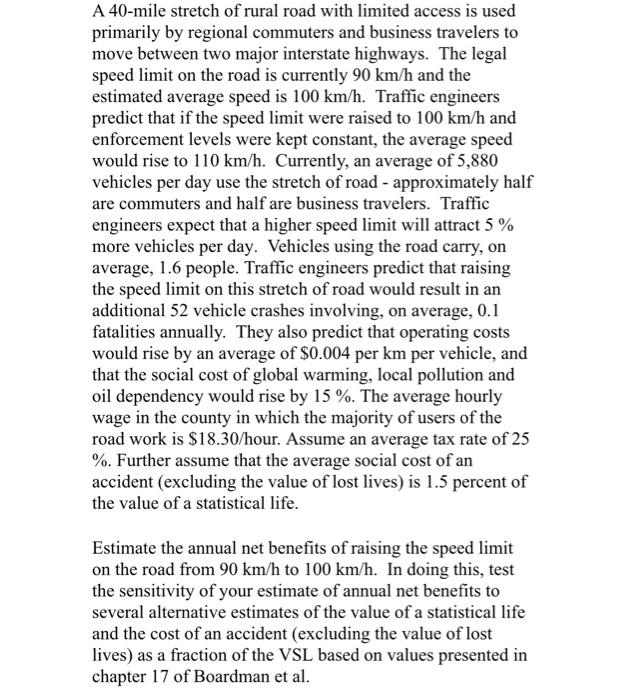A 40-mile stretch of rural road with limited access is used primarily by regional commuters and business travelers to move between two major interstate highways. The legal speed limit on the road is currently 90 km/h and the estimated average speed is 100 km/h. Traffic engineers predict that if the speed limit were raised to 100 km/h and enforcement levels were kept constant, the average speed would rise to 110 km/h. Currently, an average of 5,880 vehicles per day use the stretch of road - approximately half are commuters and half are business travelers. Traffic engineers expect that a higher speed limit will attract 5% more vehicles per day. Vehicles using the road carry, on average, 1.6 people. Traffic engineers predict that raising the speed limit on this stretch of road would result in an additional 52 vehicle crashes involving, on average, 0.1 fatalities annually. They also predict that operating costs would rise by an average of $0.004 per km per vehicle, and that the social cost of global warming, local pollution and oil dependency would rise by 15 %. The average hourly wage in the county in which the majority of users of the road work is $18.30/hour. Assume an average tax rate of 25 %. Further assume that the average social cost of an accident (excluding the value of lost lives) is 1.5 percent of the value of a statistical life. Estimate the annual net benefits of raising the speed limit on the road from 90 km/h to 100 km/h. In doing this, test the sensitivity of your estimate of annual net benefits to several alternative estimates of the value of a statistical life and the cost of an accident (excluding the value of lost lives) as a fraction of the VSL based on values presented in chapter 17 of Boardman et al. A 40-mile stretch of rural road with limited access is used primarily by regional commuters and business travelers to move between two major interstate highways. The legal speed limit on the road is currently 90 km/h and the estimated average speed is 100 km/h. Traffic engineers predict that if the speed limit were raised to 100 km/h and enforcement levels were kept constant, the average speed would rise to 110 km/h. Currently, an average of 5,880 vehicles per day use the stretch of road - approximately half are commuters and half are business travelers. Traffic engineers expect that a higher speed limit will attract 5% more vehicles per day. Vehicles using the road carry, on average, 1.6 people. Traffic engineers predict that raising the speed limit on this stretch of road would result in an additional 52 vehicle crashes involving, on average, 0.1 fatalities annually. They also predict that operating costs would rise by an average of $0.004 per km per vehicle, and that the social cost of global warming, local pollution and oil dependency would rise by 15 %. The average hourly wage in the county in which the majority of users of the road work is $18.30/hour. Assume an average tax rate of 25 %. Further assume that the average social cost of an accident (excluding the value of lost lives) is 1.5 percent of the value of a statistical life. Estimate the annual net benefits of raising the speed limit on the road from 90 km/h to 100 km/h. In doing this, test the sensitivity of your estimate of annual net benefits to several alternative estimates of the value of a statistical life and the cost of an accident (excluding the value of lost lives) as a fraction of the VSL based on values presented in chapter 17 of Boardman et al







